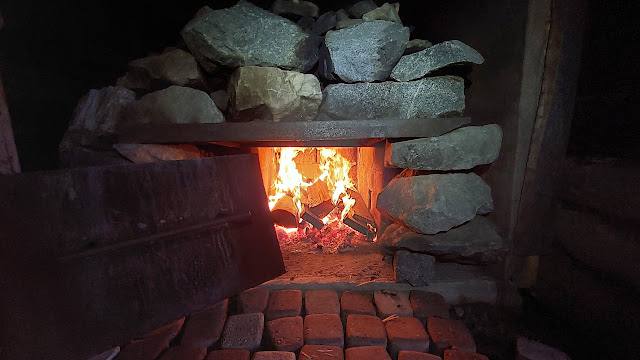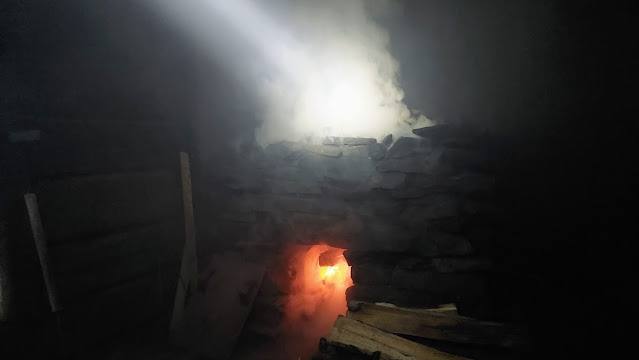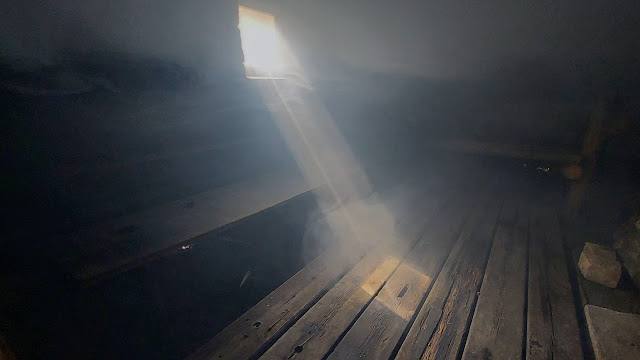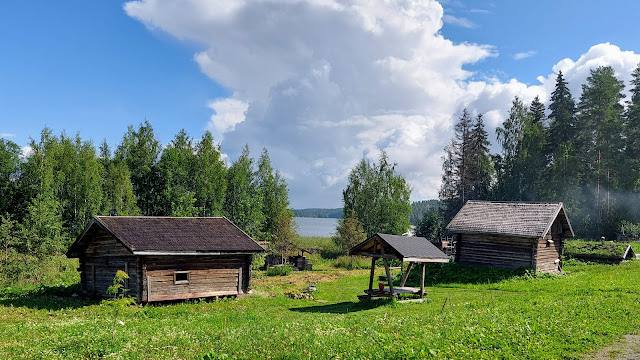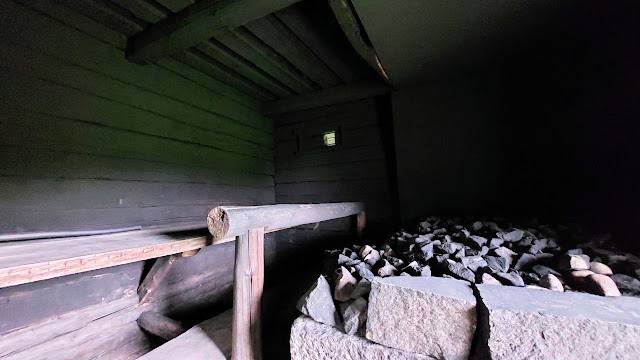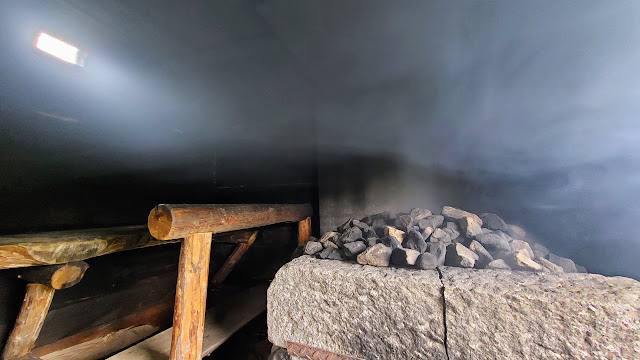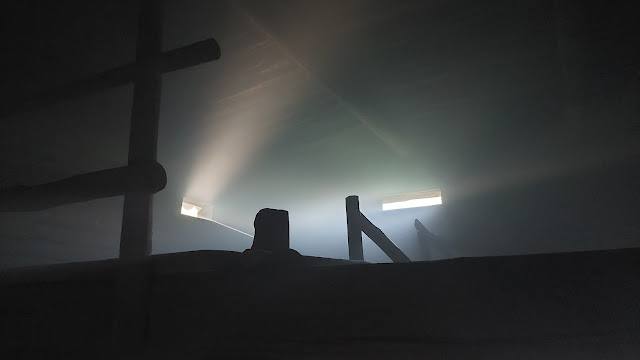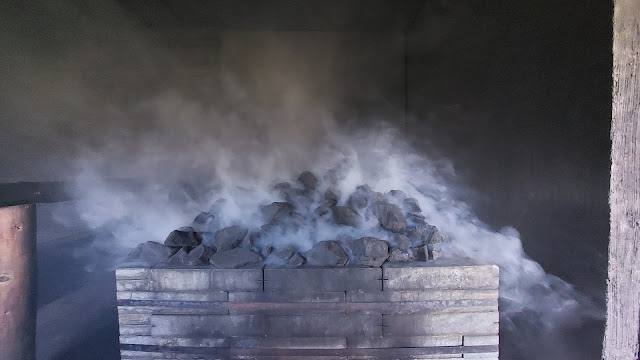Welcome to our detailed guide on the traditional Finnish practice of heating smoke saunas. Drawing from the invaluable experience of sauna enthusiasts, this article provides step-by-step instructions and essential tips to ensure a safe and enjoyable sauna experience. Special thanks to Jyrki Kokko for his extensive work on documenting these practices, which you can explore further here.
Instructions for heating smoke saunas
The heating of the saunas starts at around ten. Virpiö’s heating starts as early as seven o’clock. With this schedule, you can go to the sauna at four in the afternoon.Attached is a “quick guide” for heating the smoke sauna.
- Before heating, open the smoke flaps from the wall and the ceiling horn
- The lye water is put into the sauna inside the sauna, because later it won’t work because of the smoke
- It is ensured that outside the sauna there are so-called extinguishing water
- The grate or “metal grid” is placed at the bottom of the firebox
- Trees of a suitable size are placed under the pile of stones, either long or short trees, depending on the stove
- Toho is used to set the trees on fire, toho is the surest way
- After ignition, put the spark damper in front of the stove, but leave a clear gap for air to flow into the firebox
- Trees are added to the saunas every half hour, a good way is to add trees from one side and the other
- The sauna door is kept open at least 10-20 cm during heating
- If the fire comes from between the stones (smoke gas fire) after the addition of trees, it must be extinguished immediately with water
- In the final stage, the temperature between the stones of the stove is measured, which must be around 300 C, i.e. the lowest stones must be so-called glowing red
- By two o’clock the stoves are at a more or less suitable temperature
- The last trees are put in around two o’clock
- At three o’clock the ashes are removed from the nest. First, the grate is removed with a grate iron, and then the ashes are placed in ash trays
- The grate and ashes are taken to the yard. The grate should be removed immediately before removing the ashes. The grate and ashes should be placed outside the sauna in such a place that there is no danger
- The flaps are closed, as is the lakin
- The spark dampers are placed completely closed in the stove after removing the ashes, so that the air circulation does not cool the stones
- Finally, throw away the scumbags and rinse the boards clean with water and close the door
- Then let the stoves be “making” i.e. heating up
- Between two and three, the washing water of the water dams had to be heated, remember that, sure game
- Finally, if necessary, we put the LED storm lanterns in place on the rafts
- Peflets, drinking mugs and water containers are placed in front of the sauna
- From four, everything is ready for the saunas, i.e. for the customers
Heating instruction for heaters of smoke saunas
This instruction aims to prevent smoke saunas from burning during heating. The instructions have been compiled based on experience-based information.
- open the flaps and horn before starting the heating
- make sure that the grate (right rosti) is in the hearth
- add trees to about half the area of the hatch
- monitors the temperature of the stove and structures
- measurement is made with a laser meter (celsius scale)
- the temperature of the structures is always measured before adding trees, when the heating has been done for more than two (2) hours
- the temperature of the stones in the stove must not rise much above three hundred degrees (+ 300 C)
- the surface temperature of the walls and ceiling must not rise above one hundred degrees (+ 100 C), otherwise the risk of fire increases significantly
- during heating, the outer door is kept ajar
Slang for sauna in a smoke sauna
- Amerikan Kiehinen – A wooden stick soaked in light kerosene, which is used to light the stove’s wood.
- Grate – A metal grate in a fire pit, on which wood is burned. Actually, the metal grate is rusty. Arina is the stone platform on which e.g. let’s bake bread.
- Grate iron – A hook iron, which is used to lift the grate out of the firebox after heating, either under the shelves or out onto the wall onto stones.
- Angel’s wings – Saunoja has leaned against the sooty wall and wings have been drawn on his back.
- Häkäloylyt – Before taking a sauna, the purpose is to ventilate the ash and soot left over from the heating from the stove stones and the sauna, maybe also the carbon monoxide. After that, let the sauna cool down.
- The hair becomes hard (the hairs on the back) – The smoke sauna is heated so hot that it is not even painful to sit in the sauna.
- Fox’s tail – At the end of the heating phase, the fire gases burn on top of the stove stones when the wood is added.
- Kiheinen – There is a leaked lighter, a means of lighting a fire. It is made from wood by carving or sawing thin shavings from the surface of the piece of wood, which are stuck to the tree at the root. In this way, the surface area of the piece of wood increases and burning becomes easier. The kihinen is placed as an igniter with the chips facing down so that the fire rises between them.
- Spark damper – The damper in front of the fireplace that prevents the escape of sparks, during the heating phase is kept wide open to receive fire air and after the ashes are removed, it is closed tightly so that cold air does not flow through the stove, which cools the stove stones.
- The heater squats – The heat of the heater only lasts for a short time in the sauna, about an hour.
- Lakeinen – Smoke extraction chimney in the roof of the sauna.
- Create slush – With a long-handled slush ladle, slowly pour water into the stove’s furnace.
- Temperature measurement – In the final stage of heating the stove, the temperature of the deeper stones is measured with a laser meter between the surface stones. The temperature should be around 300-350 C. Red-glowing stones indicate that the heating was sufficient.
- Black pig in the nest – The fire has gone out in the stove. This usually happens if you handle the ignition carelessly.
- Fire water bucket – During the heating phase, there is a bucket of water outside the door and a bucket/bucket if the fire escapes during the heating phase. Foxtails are also extinguished with this water.
- Räppäna – A smoke exhaust hatch in the wall.
- Sauna Major – The person responsible for heating the sauna and taking care of the bathers; responsible for lighting the fire and adding firewood.
- Sauna hat – The hat protects your head and hair from excessive heat/humidity and also prevents headaches after the sauna. Put it on dry hair when you go to enjoy the steam in the sauna.
- Sauna gnome – Moves in the dark sauna unobtrusively, especially under the boards.
- Smoke sauna – Wood-heated traditional type of sauna, which has no chimney at all, but the fire gases spread directly into the sauna room, the stove is no longer heated during the sauna session.
- Warming – After the last addition of trees and the removal of ashes, the heat of the stove is allowed to spread and stabilize before taking a sauna.
- Stick – In the sauna, the “stick” after heating, which catches the eye, “there is a stick in the sauna”.
- Toho – A gas-powered lighter that is used when heating is started.
- Elf’s eyes – The stones of the stove are so warm that they glow red from between the cold stones outside.
- Ash shovel – A metal tool used to remove ashes from the nest after heating.
- Vasta – A bundle of twigs used in saunas, which is used for vasta (or veasting), which means hitting the vasta against the skin of the body in a hot sauna. Nowadays, it is almost always made of birch. For a birch tree, it is recommended to use young iron birch branches. Only the word is used especially in Eastern Finland.
- Vihta – Western Finland’s counterpart to the Eastern Finns.

